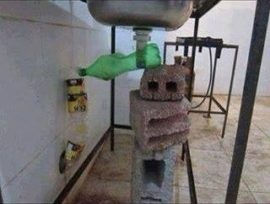
Everyone loves a good “do-it-yourself” project.
Until, of course, something goes terribly wrong.
While there’s nothing wrong with making a proactive effort to fix minor plumbing problems or perform simple installations around your home, many do-it-yourselfers make small, but critical mistakes that can end up costing them a lot of money to fix. Here are a few DIY mistakes plumbers encounter on a regular basis.
1: Wrong Toilet Placement
Replacing the toilet might seem like a simple project, and it usually doesn’t present too many problems. Provided that you remember to shut off the water lines (more on that in a moment) and empty the water already in the toilet, the process is fairly easy for an aspiring do-it-yourselfer. In some cases, however, you might find that the new toilet doesn’t quite fit as neatly into the space your old toilet occupied.
The culprit is usually an irregular “rough-in,” the measurement that determines the distance from the finished wall to the toilet’s nearest floor bolt. Most modern homes feature a standard rough-in of 12 inches, but in older homes it could range from 10 to 14 inches. If you can’t find a toilet that accommodates this space, you could end up having to move the drain, which can be a major (and expensive) project.
Also, it’s a good idea to note the shape and diameter of the bowl before you buy a new toilet. You’ll get tired of explaining to guests why the bathroom door bangs against the lip of the toilet if you replace a rounded bowl with an elongated one.
2: Not Sloping the Shower Floor
While there have certainly been plenty of technological innovations in the plumbing industry, it’s easy to forget that at its core, plumbing relies on gravity to do most of the heavy lifting. When water can’t flow downward, it sits and stagnates, becoming a breeding ground for mold, mildew, and bacteria.
Shower stalls with tile floors need to be slanted at a precise angle to ensure that water will flow to the drain rather than pooling and seeping into the grout. A typical shower floor should be sloped at a four percent angle, dropping roughly 1/2 inch for every 12 inches from the shower wall to the drain. Failing to take this slope into account during installation can lead to expensive problems later.
3: Mismatched Pipes
Modern plumbing utilizes a wide array of materials for piping. From galvanized steel to copper to brass to plastic and everything in between, sorting out what kind of pipe to use where can be confusing for the aspiring do-it-yourselfer. Some of these pipes can be joined together using specialized connections, although this is very rarely ideal and always poses a leak risk. Others should not be mixed under any circumstances.
All too often, people decide to just “make it work” by cobbling together mismatched connections and filling the gaps with tape or silicone. Most plumbers have at least one or two horror stories about finding tangled, leaky pipes under a sink or finding makeshift connections that have failed somewhere behind the drywall. Unless you have absolutely no other option, it’s usually better to simply replace old pipes rather than trying to connect them to a different kind of pipe.
4: Over-tightening Connections
Another common problem, this one is a bit counterintuitive. Most people know that plumbing connections need to be watertight. What they may not think about is how most connections already make a watertight seal, so they go about making the connection tighter to make it “more watertight.” Oftentimes this can actually damage the fittings and break the rubber or plastic washers that create the seal in the first place. Too much tightening can also strip pipe threads or crack plastic fittings, rendering the connection useless.
While connections should always be snug, don’t try to force anything past that point. Even if over-tightening doesn’t cause damage, it can cause massive headaches for anyone who has to replace the fitting in the future. Trying to loosen an over-tightened connection can cause serious damage, sometimes snapping the pipe or wearing the fittings down to the point that the only way to remove them is to cut the pipe.
5: Forgetting How Things Go Back Together
This might seem like an obvious precaution, but it can be all too easy to forget how your drain trap is supposed to be assembled when the pieces are scattered across your kitchen floor. While newly purchased plumbing pieces generally come with instructions or at least a picture to follow, if you’re taking your drain apart to clear a clog, you might not have a reference point when it’s time to reassemble everything.
And putting things back the right way matters. A drain trap might seem like a minor contraption, but if improperly assembled, it can allow sewer gas to travel up through the pipes and make your house smell like a septic tank. Mixing up the pieces of your fixtures or forgetting a seal on your toilet could cause damaging leaks. Sometimes the simple precaution of taking a picture before you tear your plumbing apart can be enough to save you from expensive headaches later.
6: Overusing Drain Cleaner
Chemical drain cleaners can be effective at clearing very minor clogs, but they often do more harm than good. The chemicals used in these cleaners can cause significant damage to pipes and fixtures over time. Used in excess, they can even build up around the clogs they’re supposed to clear, presenting a toxic danger to anyone they come into contact with. Worse, the fumes from these chemicals can make their way back up the drain to create breathing hazards.
When you have a clogged drain, it’s best to rely on natural cleaning mixtures made from vinegar, salt, baking soda, and hot water. If the clog persists, reach for a hand auger or a drain snake to physically remove the obstruction. Should both of these methods prove ineffective, it’s time to call a professional plumber.
7: Not Turning Off the Water
Although turning off the water should be the very first step in any plumbing project, it’s also an easy one to forget. Many “easy” DIY projects can turn into expensive disasters when water sprays from a loosened connection or pours freely after a fixture is removed. Shutting off the water is far easier when you have time to find the appropriate valve, but once you have water flowing onto the floor or into the walls, every moment wasted looking for the shut-off valve can cause more damage to your home.
It’s also important to remember that shutting off the water at the source doesn’t automatically clear existing water from the pipes. Make sure to drain the pipes by running the kitchen or bathroom faucets for a few seconds.
While many plumbing projects seem like an easy task, they often have the potential to spiral into more complicated and difficult undertakings. If engaging in some do-it-yourself fixes sounds too overwhelming, you can always turn to Kenny Bunch Plumbing to make sure the job is done right.
Call Us Today – 972-429-5213

